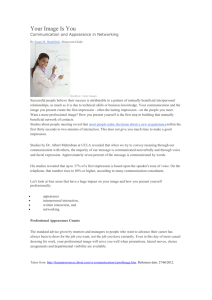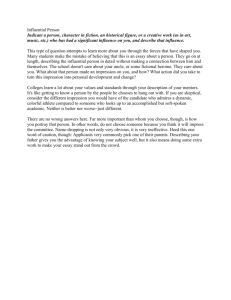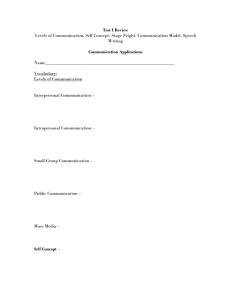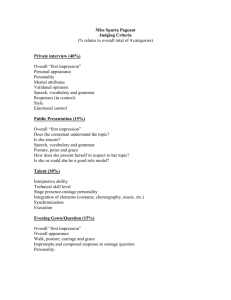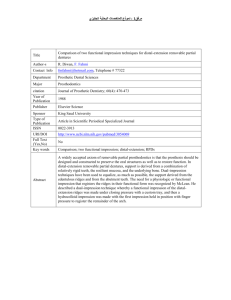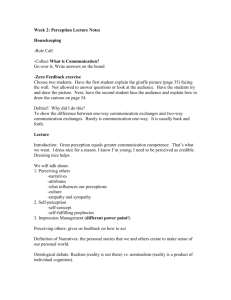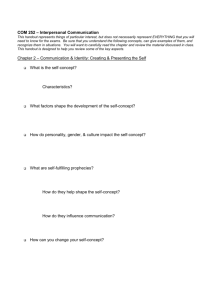Topic: Impression Formation
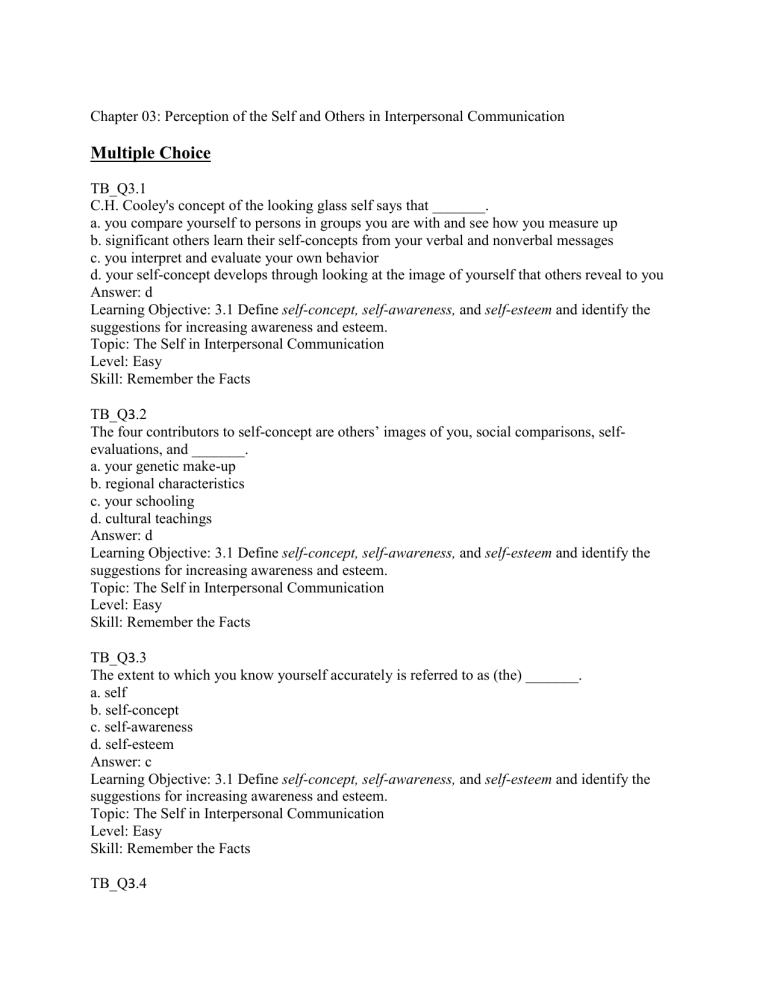
Chapter 03: Perception of the Self and Others in Interpersonal Communication
Multiple Choice
TB_Q3.1
C.H. Cooley's concept of the looking glass self says that _______. a. you compare yourself to persons in groups you are with and see how you measure up b. significant others learn their self-concepts from your verbal and nonverbal messages c. you interpret and evaluate your own behavior d. your self-concept develops through looking at the image of yourself that others reveal to you
Answer: d
Learning Objective: 3.1 Define self-concept, self-awareness, and self-esteem and identify the suggestions for increasing awareness and esteem.
Topic: The Self in Interpersonal Communication
Level: Easy
Skill: Remember the Facts
TB_Q 3 .2
The four contributors to self-concept are others’ images of you, social comparisons, selfevaluations, and _______. a. your genetic make-up b. regional characteristics c. your schooling d. cultural teachings
Answer: d
Learning Objective: 3.1 Define self-concept, self-awareness, and self-esteem and identify the suggestions for increasing awareness and esteem.
Topic: The Self in Interpersonal Communication
Level: Easy
Skill: Remember the Facts
TB_Q 3 .3
The extent to which you know yourself accurately is referred to as (the) _______. a. self b. self-concept c. self-awareness d. self-esteem
Answer: c
Learning Objective: 3.1 Define self-concept, self-awareness, and self-esteem and identify the suggestions for increasing awareness and esteem.
Topic: The Self in Interpersonal Communication
Level: Easy
Skill: Remember the Facts
TB_Q 3 .4
Which one of the four selves represents truths about yourself that neither you nor others know? a. hidden self b. blind self c. open self d. unknown self
Answer: d
Learning Objective: 3.1 Define self-concept, self-awareness, and self-esteem and identify the suggestions for increasing awareness and esteem.
Topic: The Self in Interpersonal Communication
Level: Easy
Skill: Remember the Facts
TB_Q 3 .5
Which one of the four selves represents information you know about yourself but others do not. a. hidden self b. blind self c. open self d. unknown self
Answer: a
Learning Objective: 3.1 Define self-concept, self-awareness, and self-esteem and identify the suggestions for increasing awareness and esteem.
Topic: The Self in Interpersonal Communication
Level: Easy
Skill: Remember the Facts
TB_Q 3 .6
Noxious people _______. a. criticize and find fault b. are positive and make you feel good about yourself c. employ constructive criticism d. praise and compliment
Answer: a
Learning Objective: 3.1 Define self-concept, self-awareness, and self-esteem and identify the suggestions for increasing awareness and esteem.
Topic: The Self in Interpersonal Communication
Level: Easy
Skill: Remember the Facts
TB_Q 3 .7
Which of the following is the definition of cognitive self-esteem? a. your preoccupancy with your weaknesses b. your feelings about yourself in light if your analysis of your strengths and weaknesses c. your thinking about your strengths and weaknesses d. your verbal and nonverbal behaviors
Answer: c
Learning Objective: 3.1 Define self-concept, self-awareness, and self-esteem and identify the suggestions for increasing awareness and esteem.
Topic: The Self in Interpersonal Communication
Level: Easy
Skill: Remember the Facts
TB_Q 3 .8
Gestures like rubbing your nose when you get angry, traits such as a distinct body odor, or significant details such as fight strategies, and repressed experiences are all examples of the
_______. a. hidden self b. blind self c. open self d. unknown self
Answer: b
Learning Objective: 3.1 Define self-concept, self-awareness, and self-esteem and identify the suggestions for increasing awareness and esteem.
Topic: The Self in Interpersonal Communication
Level: Medium
Skill: Understand the Concepts
TB_Q 3 .9
Your ________ varies in size depending on the situation you’re in and the person with whom you’re interacting. a. hidden self b. blind self c. open self d. unknown self
Answer: c
Learning Objective: 3.1 Define self-concept, self-awareness, and self-esteem and identify the suggestions for increasing awareness and esteem.
Topic: The Self in Interpersonal Communication
Level: Medium
Skill: Understand the Concepts
TB_Q 3 .10
Which of the following is an example of a self-affirmation? a. I don’t blame that girl for saying “no,” I’m kind of a loser. b. I'm a worthy person but there’s always room for improvement. c. My sister is so much smarter than I will ever be. d. I barely studied for this test; I’m going to do poorly.
Answer: b
Learning Objective: 3.1 Define self-concept, self-awareness, and self-esteem and identify the suggestions for increasing awareness and esteem.
Topic: The Self in Interpersonal Communication
Level: Medium
Skill: Understand the Concepts
TB_Q 3 .11
Kelvin is very open about his political views and discusses them with anyone who will listen.
This is an example of information in his ________ self. a. open b. blind c. hidden d. assertive
Answer: a
Learning Objective: 3.1 Define self-concept, self-awareness, and self-esteem and identify the suggestions for increasing awareness and esteem.
Topic: The Self in Interpersonal Communication
Level: Medium
Skill: Apply What You Know
TB_Q 3 .12
Phillip is daydreaming in class and does not hear what the teacher is saying until his name is called. This is an example of _______. a. selective attention b. selective exposure c. perceptual accentuation d. halo effect
Answer: a
Learning Objective: 3.2 Explain the five stages of perception and how they influence how you receive messages.
Topic: Perception in Interpersonal Communication
Level: Medium
Skill: Apply What You Know
TB_Q 3 .13
Noticing, reading, and listening to numerous advertisements for the car you just bought is an example of _______. a. selective attention b. selective exposure c. proximity d. resemblance
Answer: b
Learning Objective: 3.2 Explain the five stages of perception and how they influence how you receive messages.
Topic: Perception in Interpersonal Communication
Level: Medium
Skill: Understand the Concepts
TB_Q 3 .14
During this stage of interpersonal perception, you give signals some kind of meaning.
a. stimulation b. organization-interpretation c. interpretation-evaluation d. memory
Answer: c
Learning Objective: 3.2 Explain the five stages of perception and how they influence how you receive messages.
Topic: Perception in Interpersonal Communication
Level: Easy
Skill: Remember the Facts
TB_Q 3 .15
In this stage of the perceptual process, you create "cognitive tags." a. organization b. memory c. recall d. stimulation
Answer: b
Learning Objective: 3.2 Explain the five stages of perception and how they influence how you receive messages.
Topic: Perception in Interpersonal Communication
Level: Medium
Skill: Understand the Concepts
TB_Q 3 .16
You see a group of people physically close together and conclude they are friends or coworkers.
This is the principle of _______. a. proximity b. similarity c. selective attention d. selective exposure
Answer: a
Learning Objective: 3.2 Explain the five stages of perception and how they influence how you receive messages.
Topic: Perception in Interpersonal Communication
Level: Medium
Skill: Apply What You Know
TB_Q 3 .17
Andre assumed Rachel worked at the hospital because she was dressed in scrubs. This is an example of the rule of _______. a. contrast. b. similarity. c. stereotyping. d. proximity.
Answer: b
Learning Objective: 3.2 Explain the five stages of perception and how they influence how you receive messages.
Topic: Perception in Interpersonal Communication
Level: Medium
Skill: Apply What You Know
TB_Q 3 .18
Your friend, Pat, was born into a wealthy family. Every time he succeeds in life, people claim it's due to his family's money. This would be an example of _______. a. a fundamental attribution error b. perceptual accentuation c. consistency d. overattribution
Answer: d
Learning Objective: 3.3 Define the major impression formation processes and the ways to increase accuracy.
Topic: Impression Formation
Level: Medium
Skill: Apply What You Know
TB_Q 3 .19
Laura was often late to work and didn’t get along well with her supervisor. When the cash register came up $100 short, Laura was blamed. The ________ could be the reason she was accused. a. halo effect b. self-serving bias c. reverse halo effect d. fundamental attribution error.
Answer: c
Learning Objective: 3.3 Define the major impression formation processes and the ways to increase accuracy.
Topic: Impression Formation
Level: Medium
Skill: Apply What You Know
TB_Q 3 .20
Reggie is well-dressed, friendly and on time to his job interview. Therefore, the interviewer also assumes he is intelligent and capable. This is an example of the _______. a. self-serving bias b. self-fulfilling prophecy c. halo effect d. reverse halo effect
Answer: c
Learning Objective: 3.3 Define the major impression formation processes and the ways to increase accuracy.
Topic: Impression Formation
Level: Medium
Skill: Apply What You Know
TB_Q 3 .21
If you believe you're going to score an "A" on a test, you may start studying more, which in turn may lead you to receive that high grade. This would exemplify the _______. a. schema effect. b. Pollyanna effect. c. implicit personality theory. d. self-fulfilling prophecy.
Answer: d
Learning Objective: 3.3 Define the major impression formation processes and the ways to increase accuracy.
Topic: Impression Formation
Level: Medium
Skill: Apply What You Know
TB_Q 3 .22
Coach Campbell believes the best of each of his players and assumes they all work hard and receive good grades. As a result, most of his players do work hard and receive good grades. This is an example of what? a. the Pygmalion effect b. implicit personality theory c. Pollyanna effect d. self-serving bias
Answer: a
Learning Objective: 3.3 Define the major impression formation processes and the ways to increase accuracy.
Topic: Impression Formation
Level: Medium
Skill: Apply What You Know
TB_Q 3 .23
The perceptual process in which you're more influenced by what you sense first or last is
________. a. proximity and consensus b. primacy and recency c. consensus and resemblance d. consistency and distinctiveness
Answer: b
Learning Objective: 3.3 Define the major impression formation processes and the ways to increase accuracy.
Topic: Impression Formation
Level: Easy
Skill: Remember the Facts
TB_Q 3 .24
A stereotype is a(n) _______. a. organized body of information about some action, event or procedure b. example of self-fulfilling prophecy c. fixed impression of a group of people d. self-serving bias
Answer: c
Learning Objective: 3.3 Define the major impression formation processes and the ways to increase accuracy.
Topic: Impression Formation
Level: Easy
Skill: Remember the Facts
TB_Q 3 .25
In the ________, you take credit for the positive and deny responsibility for the negative. a. self-serving bias b. self-fulfilling prophecy c. Pollyanna effect d. Pygmalion effect
Answer: a
Learning Objective: 3.3 Define the major impression formation processes and the ways to increase accuracy.
Topic: Impression Formation
Level: Easy
Skill: Remember the Facts
TB_Q 3 .26
In order, the stages of the perceptual process are _______. a. receiving, understanding, remembering, evaluating, and responding b. stimulation, interpretation-evaluation, organization, memory, and recall c. stimulation, organization, interpretation-evaluation, memory, and recall d. receiving, evaluating, understanding, remembering, and responding
Answer: c
Learning Objective: 3.2 Explain the five stages of perception and how they influence how you receive messages.
Topic: Perception in Interpersonal Communication
Level: Easy
Skill: Remember the Facts
TB_Q 3 .27
Which of the following is a suggestion for how to increase accuracy in impression formation? a. increase cultural sensitivity b. ignore your role in perception c. accept uncertainty d. draw early conclusions
Answer: a
Learning Objective: 3.3 Define the major impression formation processes and the ways to increase accuracy.
Topic: Impression Formation
Level: Easy
Skill: Remember the Facts
TB_Q 3 .28
Veronique mistook Callie's friendly attitude and politeness for genuine liking and friendship, perhaps because she was looking for a friend at that time. When you see what you want to see, this is called _______. a. perceptual accentuation b. overattribution c. the fundamental attribution error d. the self-serving bias
Answer: a
Learning Objective: 3.3 Define the major impression formation processes and the ways to increase accuracy.
Topic: Impression Formation
Level: Medium
Skill: Apply What You Know
TB_Q 3 .29
Which of the following is an example of consistency in impression formation? a. Because she is smart, I also assume she enjoys reading. b. Because she is religious, I assume she is judgmental. c. Because he is a male, I assume he also enjoys watching football. d. Because I think she is a good person, I assume she does good things.
Answer: d
Learning Objective: 3.3 Define the major impression formation processes and the ways to increase accuracy.
Topic: Impression Formation
Level: Medium
Skill: Understand the Concepts
TB_Q 3 .30
If the cause of a person's behavior is a personality trait of that person, then the cause is _______. a. external b. internal c. motivational d. environmental
Answer: b
Learning Objective: 3.3 Define the major impression formation processes and the ways to increase accuracy.
Topic: Impression Formation
Level: Medium
Skill: Understand the Concepts
TB_Q 3 .31
"I know why she was late. She’s irresponsible and inconsiderate," is an example of _______. a. a self-fulfilling prophecy b. the fundamental attribution error c. overattribution d. consistency
Answer: b
Learning Objective: 3.3 Define the major impression formation processes and the ways to increase accuracy.
Topic: Impression Formation
Level: Medium
Skill: Understand the Concepts
TB_Q 3 .32
Affinity-seeking strategies increase _______. a. our chances of being liked b. our cultural identification c. judgment d. our chances of being rejected
Answer: a
Learning Objective: 3.4 Explain the impression management strategies that may help you to be liked, to be believed, to excuse failure, to secure help, to hide faults, to be followed, and to confirm your self-image.
Topic: Impression Management: Goals and Strategies
Level: Easy
Skill: Remember the Facts
TB_Q 3 .33
Credibility strategies seek to establish your competence, character, and _______. a. creativity b. capability c. comprehension d. charisma
Answer: d
Learning Objective: 3.4 Explain the impression management strategies that may help you to be liked, to be believed, to excuse failure, to secure help, to hide faults, to be followed, and to confirm your self-image.
Topic: Impression Management: Goals and Strategies
Level: Easy
Skill: Remember the Facts
TB_Q 3 .34
Self-handicapping strategies serve the purpose of _______. a. excusing failure b. confirming self-image
c. securing help d. hiding faults
Answer: a
Learning Objective: 3.4 Explain the impression management strategies that may help you to be liked, to be believed, to excuse failure, to secure help, to hide faults, to be followed, and to confirm your self-image.
Topic: Impression Management: Goals and Strategies
Level: Easy
Skill: Remember the Facts
TB_Q 3 .35
Expressions such as, "I can understand why you're so angry," "It's okay to talk about fear," and asking if your phone call comes at a good time are all examples of _______. a. other-orientation b. overattribution c. the self-serving bias d. perception checking
Answer: a
Learning Objective: 3.4 Explain the impression management strategies that may help you to be liked, to be believed, to excuse failure, to secure help, to hide faults, to be followed, and to confirm your self-image.
Topic: Impression Management: Goals and Strategies
Level: Medium
Skill: Understand the Concepts
True and False
TB_Q 3 .36
Self-awareness is the extent to which you accurately know yourself. a. True b. False
Answer: a
Learning Objective: 3.1 Define self-concept, self-awareness, and self-esteem and identify the suggestions for increasing awareness and esteem.
Topic: The Self in Interpersonal Communication
Level: Easy
Skill: Remember the Facts
TB_Q 3 .37
According to the text, it is unhealthy to use social comparisons to form your self-concept. a. True b. False
Answer: b
Learning Objective: 3.1 Define self-concept, self-awareness, and self-esteem and identify the suggestions for increasing awareness and esteem.
Topic: The Self in Interpersonal Communication
Level: Easy
Skill: Remember the Facts
TB_Q 3 .38
The self-concept, unlike other communication constructs, is rather independent of cultural influence. a. True b. False
Answer: b
Learning Objective: 3.1 Define self-concept, self-awareness, and self-esteem and identify the suggestions for increasing awareness and esteem.
Topic: The Self in Interpersonal Communication
Level: Easy
Skill: Remember the Facts
TB_Q 3 .39
The Johari Window represents the four major components of self-awareness. a. True b. False
Answer: a
Learning Objective: 3.1 Define self-concept, self-awareness, and self-esteem and identify the suggestions for increasing awareness and esteem.
Topic: The Self in Interpersonal Communication
Level: Easy
Skill: Remember the Facts
TB_Q 3 .40
The unknown self represents information about you that is known to others, but not to self. a. True b. False
Answer: b
Learning Objective: 3.1 Define self-concept, self-awareness, and self-esteem and identify the suggestions for increasing awareness and esteem.
Topic: The Self in Interpersonal Communication
Level: Easy
Skill: Remember the Facts
TB_Q 3 .41
The measure of how valuable you think you are is self-esteem. a. True b. False
Answer: a
Learning Objective: 3.1 Define self-concept, self-awareness, and self-esteem and identify the suggestions for increasing awareness and esteem.
Topic: The Self in Interpersonal Communication
Level: Easy
Skill: Remember the Facts
TB_Q 3 .42
The process of perception occurs in three continuous stages that blend into one another. a. True b. False
Answer: b
Learning Objective: 3.2 Explain the five stages of perception and how they influence how you receive messages.
Topic: Perception in Interpersonal Communication
Level: Easy
Skill: Remember the Facts
TB_Q 3 .43
Schemata are mental templates that we create to provide us with general ideas about people. a. True b. False
Answer: a
Learning Objective: 3.2 Explain the five stages of perception and how they influence how you receive messages.
Topic: Perception in Interpersonal Communication
Level: Easy
Skill: Remember the Facts
TB_Q 3 .44
We are more likely to remember information if it is consistent with our schema. a. True b. False
Answer: a
Learning Objective: 3.2 Explain the five stages of perception and how they influence how you receive messages.
Topic: Perception in Interpersonal Communication
Level: Easy
Skill: Remember the Facts
TB_Q 3 .45
One rule of perception is that of proximity, or physical closeness. According to this theory, things that are physically close are perceived as a unit. a. True b. False
Answer: a
Learning Objective: 3.2 Explain the five stages of perception and how they influence how you receive messages.
Topic: Perception in Interpersonal Communication
Level: Easy
Skill: Remember the Facts
TB_Q 3 .46
The tendency to infer that a person has many positive attributes based on the belief that he or she has some positive qualities is called the Pygmalion effect. a. True b. False
Answer: b
Learning Objective: 3.3 Define the major impression formation processes and the ways to increase accuracy.
Topic: Impression Formation
Level: Easy
Skill: Remember the Facts
TB_Q 3 .47
The process of perceptual accentuation causes us to see what we want or expect to see. a. True b. False
Answer: a
Learning Objective: 3.3 Define the major impression formation processes and the ways to increase accuracy.
Topic: Impression Formation
Level: Easy
Skill: Remember the Facts
TB_Q 3 .48
Research on the primacy-recency effect confirms the belief that first impressions do not really matter. a. True b. False
Answer: b
Learning Objective: 3.3 Define the major impression formation processes and the ways to increase accuracy.
Topic: Impression Formation
Level: Easy
Skill: Remember the Facts
TB_Q 3 .49
The tendency to maintain balance among perceptions or attitudes is called attribution of control. a. True b. False
Answer: b
Learning Objective: 3.3 Define the major impression formation processes and the ways to increase accuracy.
Topic: Impression Formation
Level: Easy
Skill: Remember the Facts
TB_Q 3 .50
The primary-recency effect tends to heighten the accuracy of perception. a. True b. False
Answer: b
Learning Objective: 3.3 Define the major impression formation processes and the ways to increase accuracy.
Topic: Impression Formation
Level: Easy
Skill: Remember the Facts
TB_Q 3 .51
The self-serving bias leads us to take credit for the positive and to deny responsibility for the negative. a. True b. False
Answer: a
Learning Objective: 3.3 Define the major impression formation processes and the ways to increase accuracy.
Topic: Impression Formation
Level: Easy
Skill: Remember the Facts
TB_Q 3 .52
JoAnn is such an extrovert. She engages in friendly conversation with just about everyone with whom she comes into contact throughout the day, and she seems to attract others to her like a magnet. My perception of JoAnn is being influenced primarily by the personality theory. a. True b. False
Answer: a
Learning Objective: 3.3 Define the major impression formation processes and the ways to increase accuracy.
Topic: Impression Formation
Level: Moderate
Skill: Apply What You Know
TB_Q 3 .53
Stereotyping includes phrases like "All women are. . ." or "All Baptists are. . ." a. True b. False
Answer: a
Learning Objective: 3.3 Define the major impression formation processes and the ways to increase accuracy.
Topic: Impression Formation
Level: Moderate
Skill: Apply What You Know
TB_Q 3 .54
When Ron goes to eat dinner, he expects to be seated and receive a menu; then a server will take his drink order, take his dinner order, and later bring the check. This is an example of a stereotype. a. True b. False
Answer: b
Learning Objective: 3.3 Define the major impression formation processes and the ways to increase accuracy.
Topic: Impression Formation
Level: Moderate
Skill: Apply What You Know
TB_Q 3 .55
Politeness in interpersonal communication refers to behavior that allows others to maintain both positive and negative face. a. True b. False
Answer: a
Learning Objective: 3.4 Explain the impression management strategies that may help you to be liked, to be believed, to excuse failure, to secure help, to hide faults, to be followed, and to confirm your self-image.
Topic: Impression Management: Goals and Strategies
Level: Easy
Skill: Remember the Facts
Essay
TB_Q 3 .56
Chris, while managing at Pizza Bob's, has recently become very depressed, and is interested in increasing his self-awareness. Briefly give Chris some suggestions.
Answer: Chris, ask yourself about yourself, listen to others, actively seek information about yourself, see your different selves, and increase your open self.
Learning Objective: 3.1 Define self-concept, self-awareness, and self-esteem and identify the suggestions for increasing awareness and esteem.
Topic: The Self in Interpersonal Communication
Level: Hard
Skill: Analyze It
TB_Q 3 .57
To what extent do you subscribe to the self-destructive beliefs mentioned in the text? What can you do to reverse them?
Answer: Students may respond with such beliefs as the following:
1. To be perfect
2. To be strong
3. To please
4. To hurry up
5. To take on too much responsibility.
Learning Objective: 3.1 Define self-concept, self-awareness, and self-esteem and identify the suggestions for increasing awareness and esteem.
Topic: The Self in Interpersonal Communication
Level: Hard
Skill: Analyze It
TB_Q 3 .58
You just learned about the Johari window and your psychology teacher wants you to explain it to the class. Explain the window and give examples.
Answer:
1. Open self: information known to self and others
2. Blind self: information known only to others
3. Hidden self: information known only to self
4. Unknown self: information known to neither self nor other
Learning Objective: 3.1 Define self-concept, self-awareness, and self-esteem and identify the suggestions for increasing awareness and esteem.
Topic: The Self in Interpersonal Communication
Level: Hard
Skill: Analyze It
TB_Q 3 .59
Define a self-fulfilling prophecy. In what ways might a self-fulfilling prophecy be positive or negative? How might you use the concept to your benefit?
Answer: A self-fulfilling prophecy is a prediction that becomes true because you act on it as if it were true. They can be positive in that they can help you achieve a goal, but negative in that you may see what you predict, rather than what's actually there. Examples of how you can use the concept to the individual's benefit will vary with the individual.
Learning Objective: 3.3 Define the major impression formation processes and the ways to increase accuracy.
Topic: Impression Formation
Level: Hard
Skill: Analyze It
TB_Q 3 .60
After overcoming some initial anxiety, Pat is enjoying an intercultural exchange trip but is having trouble getting to know Mei, her host. Share some uncertainty reduction strategies with
Pat.
Answer: Pat, try to observe Mei engaged in various activities, ask others about Mei, and talk to
Mei directly. Ask questions, and the like. But be careful, Pat. All cultures tolerate different amounts of uncertainty and deal with it differently. You might have to tolerate more uncertainty than you're used to.
Learning Objective: 3.3 Define the major impression formation processes and the ways to increase accuracy.
Topic: Impression Formation
Level: Hard
Skill: Analyze It
TB_Q3.61
We tend to use seven strategies to shape our image and put forth a good impression. Choose
3 of the 7 and describe how you have used them in interpersonal communication.
Answer: Answers should include examples that illustrate the following goals: To be liked, to be believed, to excuse failure, to secure help, to hide faults, to be followed, to confirm self-image.
Answers should also define the type of strategies used including affinity, credibility, selfhandicapping, self-deprecating, self-monitoring, influencing, and image-confirming strategies.
Learning Objective: 3.4 Explain the impression management strategies that may help you to be liked, to be believed, to excuse failure, to secure help, to hide faults, to be followed, and to confirm your self-image.
Topic: Impression Management: Goals and Strategies
Level: Hard
Skill: Analyze It
